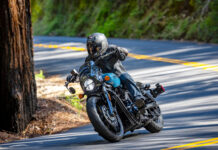A little bit faster, a little bit lighter, a little bit more compact than before…so goes the well-proven formula that’s marked the progress of sportbikes since the first CBR900RR turned the niche upside down in 1992. Back then, the world’s fastest bikes had been getting bigger, heavier and more powerful in their quest for rival-crushing speed, a trend Honda’s Senior Designer Tadao Baba bucked dramatically by gaining performance through losing avoirdupois. Hence the debut CBR900RR (“Fireblade” most places overseas) produced less power than its rivals from its smaller 893cc engine at 121 horsepower, but with its ruthlessly pared 408-pound dry weight simultaneously consigned them to competing effectively with a pillion passenger’s worth of surplus metal. It was faster in a straight line, would vanish given some corners and it put the “sport” back into sportbike.
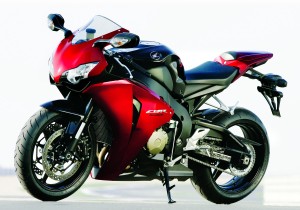
It took Yamaha another six years to see the lightness light, Suzuki even longer and Kawasaki well into the next century, but now all are following Honda’s path with the zeal of religious devotees, and sportbikes are massively better for it, as it were. No room then for further revelationary conversions you’d have thought, but Honda, it seems, has done it again with the 2008 CBR1000RR, albeit in a quieter, more restrained fashion.
It’s not the engineering philosophy which has been upended this time around, but the styling one: just as Honda realized in the ’90s it had been giving trucks to people who wanted sportbikes, now it’s understood that superbikes have been styled like jogging suits for people who shop on Rodeo Drive. OK, exaggerating a little there, but typically a superbike buyer is a man (and they’re almost exclusively men) in his 40s or 50s, with money to spare, more Aston Martin than Impreza Turbo, and not a fan of bright colors or lots of stripes. So the new CBR is lent an air of class with some upmarket, conservative paint schemes such as the velvet red and black of our test bikes, and includes details like the inset cloisonn√© tank badges in place of the usual stickers. It’s so different to what went before it feels like a bold, even risky move, even though the bike in marketing theory at least now is styled to match the people who will be buying it. One potential hurdle is that those buyers might fit one marketing segment, but it could be they’d still like people to think they belong to another–the superbike as a midlife crisis panic purchase might yet do better to look like a young lad’s machine.
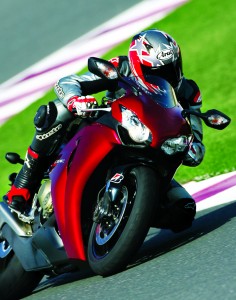
Secondly, it also has to look good and go well, and here the 2008 Honda CBR1000RR does just fine. In early pictures the snub-nosed front looked vaguely like some sea-dwelling mammal, but in the flesh it’s simply lean and purposeful like a posh MotoGP bike. It’s also remarkably small, worrying for this rider at 6 feet, 3 inches, but once on board you discover the bar-peg-seat relationship is much the same as the previous model. This is good for the majority of buyers, as the outgoing CBR had one of the most road-rider friendly ergonomic set-ups, one that made long distances perfectly feasible without phoning ahead for a chiropractor. You need to maintain some speed to gain some upper body support from the airflow, but even around town the wrists aren’t punished too severely–it’s sports, but everyday sports, not track extreme.
This all makes sense as riders if anything are growing rather than shrinking, but more of a surprise is the raw feel of the motor when you fire it up. The super-compact four-cylinder engine vibrates through the machine and almost does a double take va-rum! pick-up in response to the throttle, like a race engine and very un-Hondalike. And yet this is real progress for Honda–so often the company is criticized for the bland perfection of its bikes, but the new Blade has real character. It’s deliberately engineered-in for exactly this reason so you might conceivably still criticize it for being synthetic, but that’s nitpicking to an extreme, and anyway, Harley-Davidson does exactly the same to huge effect without complaint from its customers.
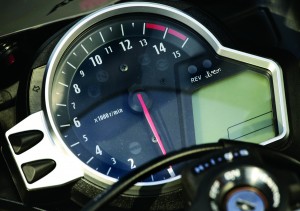
The rest of the engineering has hardly been neglected anyway. The all-new engine is a hefty 5.5-pounds lighter than the previous one, and thanks to its 1.4mm shorter stroke (the bore increases by 1mm) it has a 500-rpm higher, 13,000-rpm rev ceiling. Unlike the previous integrated unit the cylinder block is separate from the crankcase, which helps to reduce weight, while even the pistons are lighter despite their larger diameter. The slipper clutch has been designed to assist the rider with a servo action when the clutch lever is pulled in, an idea pioneered by Ducati. The underbelly exhaust is part of Honda’s continued focus on mass centralization–it’s a lot better than the previous underseat exhaust in this respect, and lighter, too, despite having to contend with stricter noise and emissions regulations.
The chassis’ emphasis is on weight reduction and centralization, and thanks to this, some 11 pounds have been lost overall compared with the old CBR1000RR, giving what Honda claims is the best power-to-weight ratio in the class. The frame in fact is around 2.5 pounds heavier than the old one, but it’s 1.2 inches narrower for improved rider control and comfort, while considerably more rigid. Lateral, torsional and vertical rigidities are increased by 13, 40 and 30 percent respectively. The swingarm is 0.63-inch longer within the same overall wheelbase, made possible by the more compact engine design. The wheels are extremely light, 0.53-pound lighter at the front and 0.82 pound lighter for the rear. The front brakes–a new monobloc caliper design–are also lighter, resulting in a total front unsprung weight reduction of about a pound.
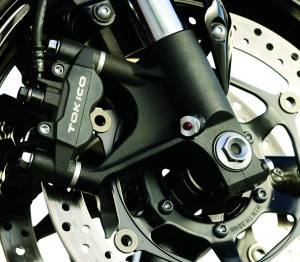
Release the light-action clutch and the bike surges forward, a loss of some low-rev torque compared with the old model countered by slightly lower gearing and that impressive weight loss. Probably thanks to the mass centralization program, the new CBR turns with significantly more eagerness and changes direction more willingly. This was especially noticeable at Qatar’s Losail circuit, where our ride took place, through the track’s high-speed left-right flicks, where the ’08 machine responded faster to less handlebar effort–I attended the ’06 model’s European launch at the same venue, so the comparison was direct.
The chassis generally is a delight, the speed-variable electronic steering damper taming corner exit waywardness without affecting agility, while feedback and manageability are as good as any road rider could want. On standard suspension settings the bike makes a good fist of high-speed track riding, and with suitable adjustments it’s a sharp circuit weapon that’s enormously satisfying as well as very forgiving and easy. This could well be 2008’s best superbike for the road, although the Suzuki GSX-R1000’s low-rev torque might still give that the edge. But Honda has finally acknowledged that road bike riders do go places on their bikes, and offers a tank- and seatbag for carrying a change of clothes and some wet-weather gear for the odd weekend away.
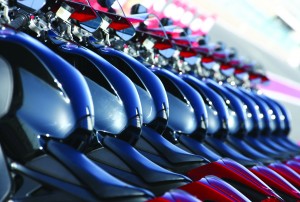
The engine, meanwhile, is as ferociously powerful as you’d expect, its 175 claimed horsepower hurling you forward like a jet fighter catapulting off the deck of an aircraft carrier. Having said that, it’s a touch shy of its rivals in outright power and doesn’t have quite the same final top-end hit of horsepower–as if you’d notice in the real world, or really want for more. The soundtrack is as interesting and evocative as the newly found feel to the motor, but it’s still as easy to modulate and obedient as Honda’s sportbikes have always been. The clutch’s self-assisting action sometimes results in odd pulses coming through the lever as you change down, but you get used to that. Less welcome are the heavy upchanges in full-bore acceleration–you have to exaggerate the throttle-off action to really unload the transmission or the gear lever can balk at selecting the next ratio, at least compared to the standard-setting Suzuki GSX-R with its crisp and featherlight shifting.
But dynamically those are the only criticisms you’ll get from me, while visually the CBR1000RR is playing a pioneering role once again. And it’s looking very good indeed.
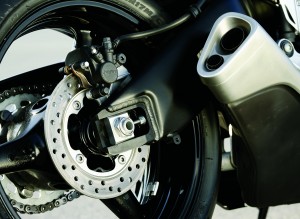
If you’re interested in the 2008 Honda CBR1000RR, you may also be interested in Rider‘s 2006 Honda CBR1000RR review.

